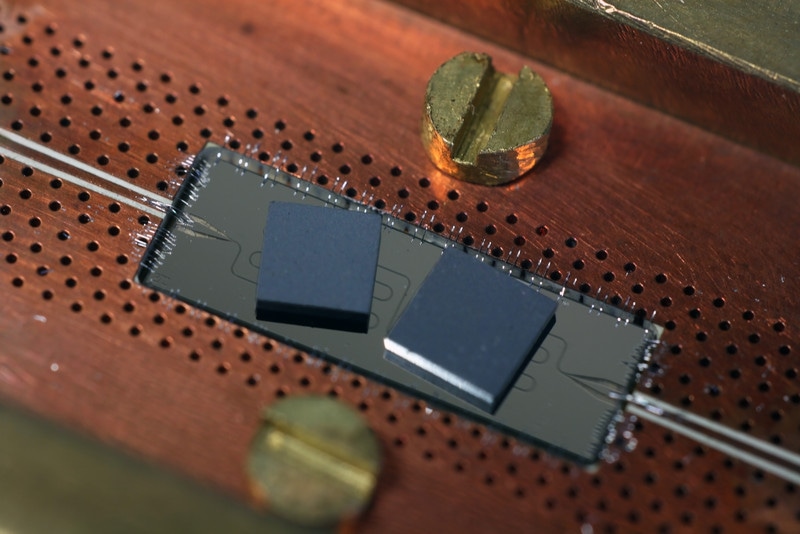Apr 11 2017
 Two black diamonds on a superconducting chip (12x4 mm). The wiggly line is a resonator, coupling the two diamonds. Credit: TU Wien
Two black diamonds on a superconducting chip (12x4 mm). The wiggly line is a resonator, coupling the two diamonds. Credit: TU Wien
Diamonds with very little flaws are capable of playing a vital role in the future of quantum technology. The quantum properties of such diamonds were studied by researchers at TU Wien for some time. However, only recently did they succeed in coupling the particular defects in two such diamonds with one another. This is indeed considered to be a significant prerequisite for the development of new applications, such as highly sensitive switches and sensors for quantum computers. The outcome of this study will be published in the journal ‘Physical Review Letters’.
In search of a suitable quantum system
“Unfortunately, quantum states are very fragile and decay very quickly”, explains Johannes Majer, head of the hybrid quantum research group, based at the Institute of Atomic and Subatomic Physics at TU Wien. It is for this reason that a detailed research is being carried out in order to find quantum systems suitable for technical applications. Till date, there has been no system capable of meeting all the requirements simultaneously even though there are some promising candidates with specific advantages.
Diamonds with very specific defects are one potential candidate for making quantum computers a reality.
Johannes Majer., Head of Hybrid Quantum Research Group, TU Wein
A pure diamond is exclusively developed from carbon atoms. However, in some diamonds there can be instances where a nitrogen atom is present instead of a carbon atom, and neighboring this, within the diamond’s atomic structure, there is an anomaly where no atom is present – this is called a ‘vacancy’. This defect, comprising of the nitrogen atom and vacancy, results in the formation of an extremely long-lasting state, producing diamonds with these specific flaws ideally suited to quantum experiments.
It all depends on the coupling
The ability to couple together such quantum systems is indeed considered to be an important pre-requisite for an increased number of quantum technological applications, as this coupling was until now only scarcely been possible for diamond systems. “The interaction between two such nitrogen-vacancy defects is extremely weak and only has a reach of around 10 nanometres”, says Majer.
This feat has thus been accomplished though with the help of a superconducting quantum chip that develops microwave radiation. For a very long time, the TU Wien team has been studying how diamonds can be manipulated by microwaves:
Billions of nitrogen-vacancy defects in diamonds are coupled collectively with a microwave field. In this way, the quantum state of the diamonds can be manipulated and read out.
Johannes Majer., Head of Hybrid Quantum Research Group, TU Wein
The researchers have now moved on to the next step as they were successful in coupling two different diamonds, one at each end of the chip, in order to develop an interaction between the two diamonds. “This interaction is mediated by the microwave resonator in the chip in between; here, the resonator plays a similar role to that of a data bus in a regular computer”, says Johannes Majer.
It is possible to selectively switch on and off the coupling between the two diamonds: “the two diamonds are rotated against each other at a certain angle”, reports Thomas Astner, the lead author of the current work. “Additionally, a magnetic field is applied, with the direction playing a decisive role: if both diamonds are aligned at the same angle within the magnetic field, then they can be coupled using quantum physics. With other magnetic field directions, it is possible to investigate the individual diamonds without coupling”. Noomi Peterschofsky took up the initial steps on the experiment as part of her undergraduate thesis. Thomas Astner and Stefan Nevlacsil subsequently succeeded in illustrating the coupling of the diamonds in an experiment that was part of their Master’s thesis.